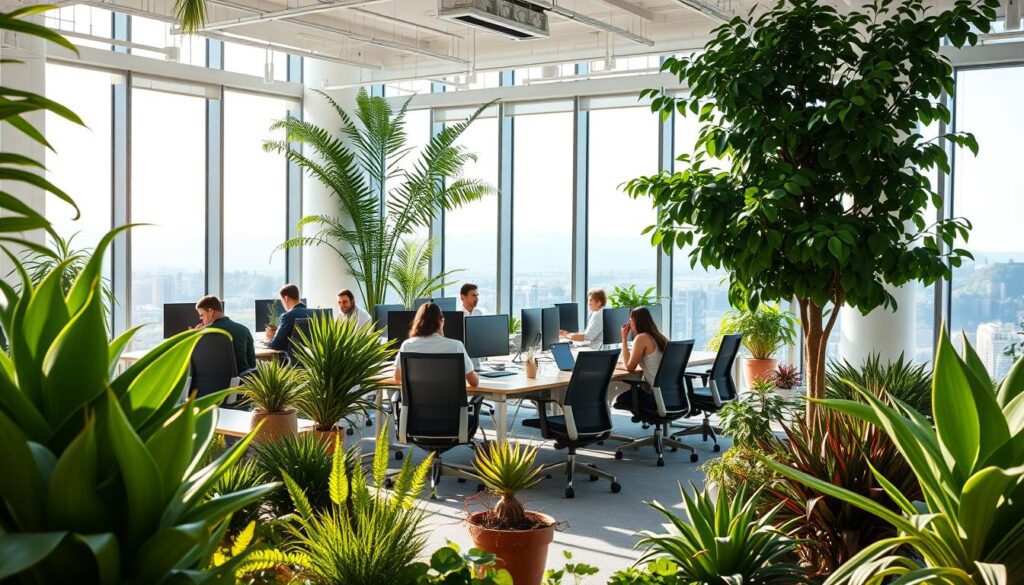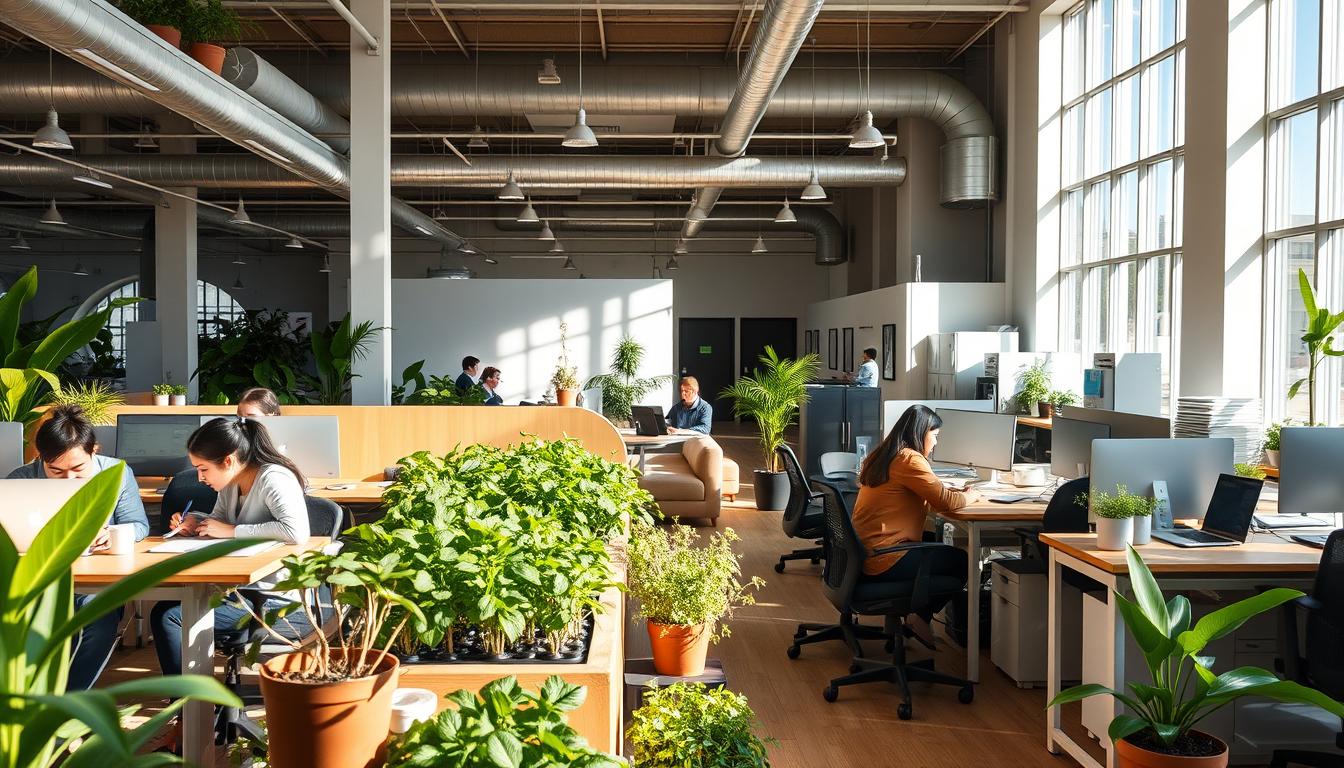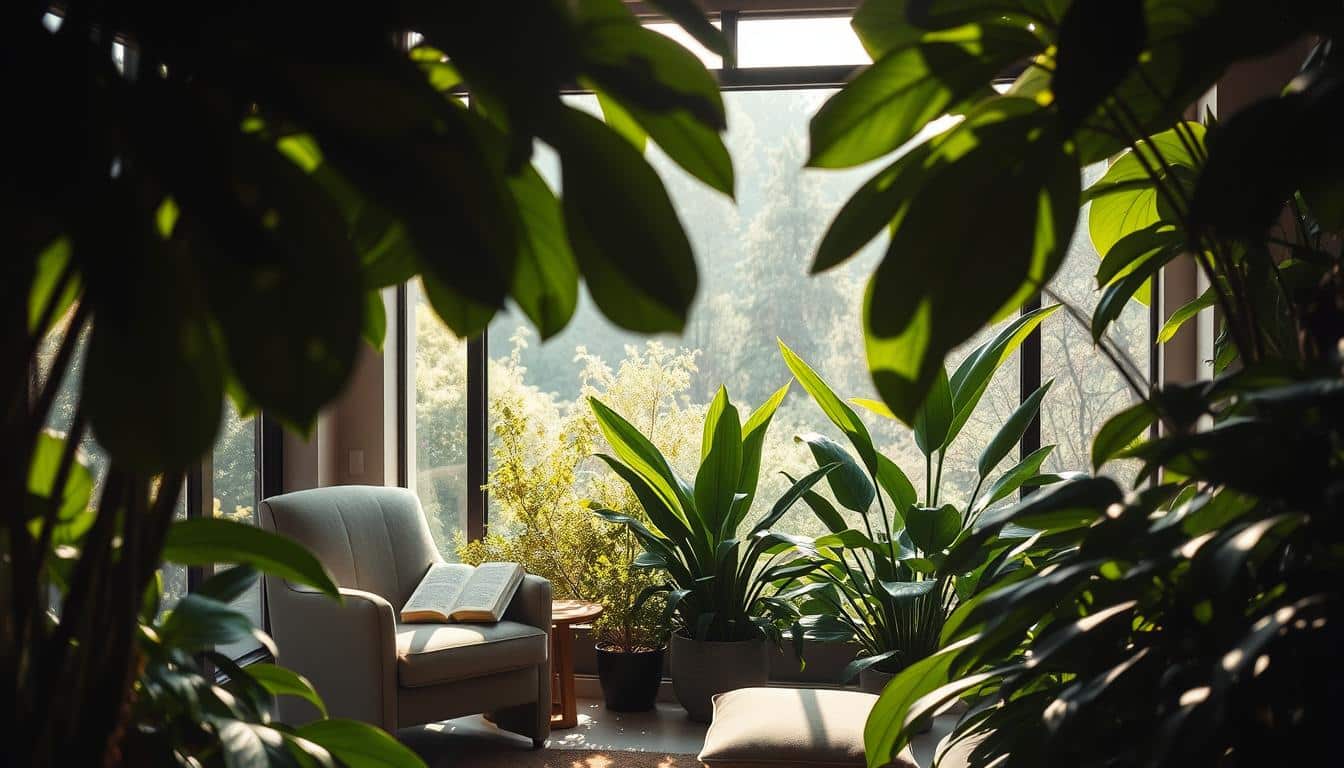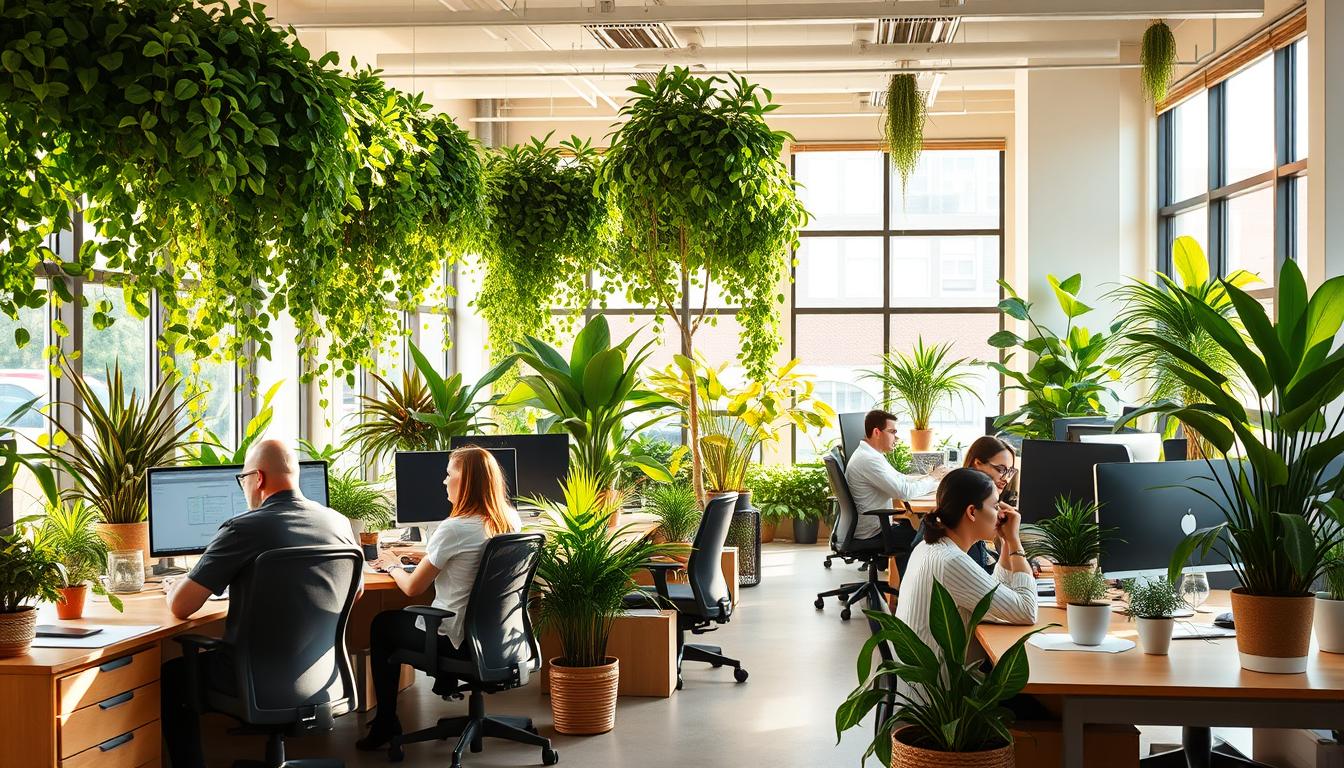Green workspaces are changing how we see offices. By adding nature into floorplans, companies see the big benefits. This makes offices look better, helps people work better, and feels healthier.
The focus is on making offices like the outdoors, peaceful and comfortable. By blending plants, colors, and open spaces, work becomes more enjoyable. This is what the future of office design looks like.
The Importance of Green Workspaces
Workplaces are changing, and having green spaces is now key. Knowing the perks of green workspaces helps employees and boosts company success. Adding nature into the design makes work areas more productive and supports employee health.
Benefits of Integrating Nature in Office Designs
Adding nature to offices comes with many benefits. Companies enjoy:
- Improved workplace productivity
- Enhanced air quality
- Reduction in noise pollution
- Creation of calming environments
This makes for a welcoming office that boosts teamwork and creativity. So, the advantages of green workspaces are quite obvious.
How Greenery Contributes to Employee Well-Being
Studies show that green spaces make employees feel better. Key findings are:
- Promotion of stress reduction by creating serene atmospheres.
- Enhanced focus and concentration for tasks at hand.
- Overall improvement in mood, leading to better job satisfaction.
By focusing on nature-based design, companies invest in their employees. A place filled with plants increases motivation and innovation, helping the whole organization.

Understanding Biophilic Design
Biophilic design is all about making workspaces that look good and make employees feel better. It weaves nature into the workplace to boost creativity and productivity. Knowing how to use biophilic design is key to making spaces that help people feel connected to nature.
Defining Biophilic Design Principles
Biophilic design uses many approaches to bring the outdoors in. It focuses on:
- Using natural elements like wood and stone to create a cozy feel.
- Bringing in more sunlight to brighten up the office.
- Adding plants to make the space look nice and clean the air.
All these things together make a workspace where people can be creative and feel good.
The Psychological Benefits of Biophilia
The good things about biophilia are not just how it looks. Studies show that being around nature-like settings can boost mental health by:
- Lowering stress so employees are more relaxed and focused.
- Improving moods, leading to happier workers.
- Helping with clearer thinking, which makes people more productive.
This way, by making offices closer to nature, companies help their staff be healthier and more motivated.
Nature-Integrated Office Floorplans
Looking into office designs that include nature helps us see what works well. Many case studies show us how to make work spaces nicer and more welcoming with bits of nature. This not only makes offices look better but helps people feel happier and work together better.
Case Studies of Successful Office Designs
There are some cool examples of how nature can fit right into where we work. For instance:
- The Loft Office by jvantspijker mixes open spaces with plants growing up the walls.
- A Hidden Garden by Muxin Design uses daylight and plants to make a peaceful spot.
These examples prove that adding nature to where we work doesn’t just look good. It also helps us get along and feel better at work.
Design Elements that Enhance Green Spaces
When you add certain things to your office, it can really improve the place. Think about these:
- Gardens that go up the walls to save space and add beauty.
- Curvy furniture that makes it easier to talk and move around.
- Plants placed just right to clean the air and soothe us.
These ideas make our work areas more calming. They help us do our jobs better and make us happier at work.
Incorporating Greenery in Office Layouts
Adding plants to office designs makes them look better and helps workers feel good. It’s key to pick indoor plants that will make the office inviting and help people do their best work. Durable plants like snake plants, pothos, and peace lilies add beauty and clean the air.
Using plants smartly changes dull offices into lively places.
Types of Plants Suitable for Indoor Environments
Choosing the right indoor plants for offices with plants is important. Here are some top choices:
- Snake Plants – They’re tough and clean the air well.
- Pothos – They grow well in low light and add greenery.
- Peace Lilies – They have pretty flowers and purify the air.
- Spider Plants – Super easy to care for and great for filtering toxins.
- ZZ Plants – They’re perfect for dim areas and very low-maintenance.
Creating a Balance Between Indoor and Outdoor Spaces
To make office designs harmonious, it’s essential to blend inside and outside areas well. Big windows and patio doors help connect with nature. They let in lots of natural light and make spaces feel open.
This approach makes places look better and helps people feel more connected to the outdoors. It makes for a happier and healthier workplace.
Color Palettes and Textures that Complement Nature
Choosing the right colors and materials is key for a harmonious workspace. Earthy color palettes help create a calm atmosphere. Browns, greens, and tans bring feelings of stability and comfort. These shades make the office look and feel soothing, affecting our minds positively.
Earthy Tones and Their Psychological Impact
Earthy tones are great for any office setting. They bring out different feelings:
- Brown gives a cozy and dependable vibe.
- Green is all about growth and renewal.
- Tan keeps things calm and balanced.
Using these colors helps make an office where people want to be creative and efficient.
The Role of Natural Materials in Office Design
Natural materials aren’t just pretty, they’re good for us too. You can use:
- Wood for desks and floors
- Stone for decorations
- Organic fabrics for comfort
They match well with earthy colors and make the office feel like the outdoors. Adding different textures makes the space more interesting and connected to nature.
Flexible Furniture Solutions for Green Workspaces
Flexible office furniture is key for green workspaces. It allows companies to change their office setup as needed. This approach leads to better use of space. It changes static areas into creative and collaborative places.
The Benefits of Modular and Adaptable Designs
Modular and adaptable designs have many benefits:
- They make it easy to change the office layout when needs change.
- They help team members work together better with flexible setups.
- They suit different work styles, good for solo or team tasks.
Examples of Furniture that Promotes Mobility and Space Utilization
Here are some examples of flexible office furniture:
- Desks that teams can rearrange for projects.
- Moveable planters that add greenery and are easy to move.
- Folding chairs and tables for space that changes as needed.
Green Roofs and Living Walls as Design Features
Adding green roofs and living walls to office designs improves city life greatly. They make areas look better and help clean the air. They also help increase the number of plants and animals in urban places.
Benefits of Vertical Gardens in Office Spaces
Vertical gardens make offices quieter by blocking noise. They help clean the air, making employees healthier and more focused. Green roofs keep buildings cooler or warmer, which cuts down energy use.
Implementation Strategies for Green Roofs
Putting in green roofs requires careful planning about the building’s strength. It must hold the extra weight of soil and plants. Picking the right plants is key. They need to grow well on your roof’s conditions. Use plants that don’t need much water and are from your area. This makes upkeep easier and helps the environment.
Creating Relaxing Zones with Nature
Setting up relaxing areas in the office is key to improving employee happiness and work output. Adding greenery to these spaces offers a refreshing break from work. Plants in break areas don’t just look nice; they also help with focus and peace of mind.
Designing Break Areas Surrounded by Greenery
Adding plants and nature to break areas makes them comforting. Here are some tips for making these spaces welcoming:
- Using a variety of indoor plants to create a lush atmosphere
- Incorporating comfortable seating arrangements that encourage relaxation
- Creating small water features, which can contribute to a tranquil ambiance
The Role of Natural Light in Relaxation Areas
Natural light plays a big role in office design, affecting mood and attention. Sunlight boosts serotonin, improving mental health. When planning relaxation areas, think about:
- Positioning seating areas near windows to maximize daylight
- Using glass partitions to allow light to filter through while maintaining open spaces
- Incorporating skylights to infuse additional natural light
Technology and Sustainability in Office Design
Using technology in office design helps bring nature inside workspaces. Smart systems keep indoor conditions perfect for plants. This helps plants grow and makes the office look nice. It also improves workers’ health and productivity.
Smart Systems for Indoor Plant Maintenance
Technology has really changed how we take care of plants indoors. There are automatic watering systems that know when plants need water. This means no one has to water them by hand all the time. There are also systems to control light and temperature. This makes sure all kinds of plants can live well inside offices. These smart systems make it easier to have plants, so employees can work better in a green office.
Energy Efficiency and Green Certifications
Using less energy in offices is now more important thanks to sustainable practices. Energy-saving devices help cut down on power use. They also help offices get green certifications. These awards show a company cares about being eco-friendly. This can make the company look better to others. Choosing energy-saving options and focusing on nature in design shows a business cares about the planet. It also makes the office a nicer place to be.
Challenges in Implementing Nature-Integrated Designs
Bringing nature into office layouts is challenging, especially in cities. In urban areas, space is often limited, making it hard to add greenery. Yet, with creativity, it’s possible to use small spaces well and keep offices looking and functioning great.
Addressing Space Limitations and Urban Conditions
In cities, the way offices are designed is heavily influenced by the available space. This makes it tough to include plants or green zones. To tackle this issue, designers have a few tricks up their sleeve:
- Utilize vertical gardens that maximize wall space.
- Incorporate planters that fit within existing furniture.
- Opt for smaller, low-maintenance plants that thrive indoors.
Overcoming Budget Constraints for Greener Designs
Budget limits can make it hard to go green in design. But, there are ways to be sustainable without spending too much. Here are some methods to try:
- Selecting native plant species that require less maintenance and water.
- Implementing green elements in phases to spread out costs.
- Collaborating with local nurseries for discounted plants and materials.
Conclusion
Bringing nature into office layouts is critical for promoting health and boosting productivity at work. Companies now understand how much a nature-focused design helps. They change their spaces to make employees healthier and happier. This move towards nature in offices shows a deep care for looks and employee well-being.
Organizations are using green design to make better workspaces. Adding plants helps reduce stress, boosts happiness, and helps everyone focus more. This approach makes the workplace better and shows that a company is a leading thinker.
To sum up, choosing designs with nature in mind is smart for workplace health. More companies are following this path. This trend is making the future of office design healthier and greener.



